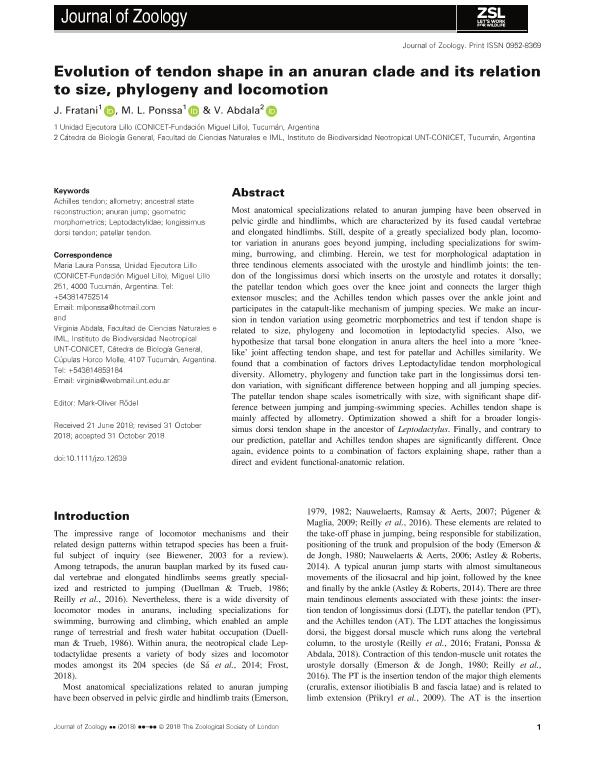Artículo
Evolution of tendon shape in an anuran clade and its relation to size, phylogeny and locomotion
Fecha de publicación:
11/2018
Editorial:
Wiley Blackwell Publishing, Inc
Revista:
Journal Of Zoology
ISSN:
0952-8369
Idioma:
Inglés
Tipo de recurso:
Artículo publicado
Clasificación temática:
Resumen
Most anatomical specializations related to anuran jumping have been observed in pelvic girdle and hindlimbs, which are characterized by its fused caudal vertebrae and elongated hindlimbs. Still, despite of a greatly specialized body plan, locomotor variation in anurans goes beyond jumping, including specializations for swimming, burrowing, and climbing. Herein, we test for morphological adaptation in three tendinous elements associated with the urostyle and hindlimb joints: the tendon of the longissimus dorsi which inserts on the urostyle and rotates it dorsally; the patellar tendon which goes over the knee joint and connects the larger thigh extensor muscles; and the Achilles tendon which passes over the ankle joint and participates in the catapult-like mechanism of jumping species. We make an incursion in tendon variation using geometric morphometrics and test if tendon shape is related to size, phylogeny and locomotion in leptodactylid species. Also, we hypothesize that tarsal bone elongation in anura alters the heel into a more ?knee-like? joint affecting tendon shape, and test for patellar and Achilles similarity. We found that a combination of factors drives Leptodactylidae tendon morphological diversity. Allometry, phylogeny and function take part in the longissimus dorsi tendon variation, with significant difference between hopping and all jumping species. The patellar tendon shape scales isometrically with size, with significant shape difference between jumping and jumping-swimming species. Achilles tendon shape is mainly affected by allometry. Optimization showed a shift for a broader longissimus dorsi tendon shape in the ancestor of Leptodactylus. Finally, and contrary to our prediction, patellar and Achilles tendon shapes are significantly different. Once again, evidence points to a combination of factors explaining shape, rather than a direct and evident functional-anatomic relation.
Archivos asociados
Licencia
Identificadores
Colecciones
Articulos(UEL)
Articulos de UNIDAD EJECUTORA LILLO
Articulos de UNIDAD EJECUTORA LILLO
Citación
Fratani Da Silva, Jéssica; Ponssa, María Laura; Abdala, Virginia Sara Luz; Evolution of tendon shape in an anuran clade and its relation to size, phylogeny and locomotion; Wiley Blackwell Publishing, Inc; Journal Of Zoology; 307; 4; 11-2018; 233-241
Compartir
Altmétricas




